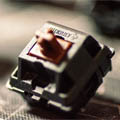Keyboard Wonderland – ENGLISH Version – Part I

First steps
I would like to share a few thoughts regarding WPM (words per minute). Whilst this article has been written at 120WPM it has also been conceived at 120MPW (minutes per word). The speed at which you type does not matter, it never did. It is more important to have – or develop – good typing habits. Your body and hands positioning, not using a wrist rest and instead floating your wrists above the keyboard, not looking for every key you want to press – these are all progressive, developed in time, in your own time. If you’re a gamer and can not actually type fast that is not a problem and eventually you will get there. If you are somebody writing for a living it is more important to write more rather than write fast and good typing habits can delay or deny development of RSI (repetitive stress injury) and major problems like carpal tunnel syndrome which can lead to serious disability.
I would also like to stress that typing speed doesn’t depend only on muscle memory. When we have to copy something it becomes even harder because the information pathway is eyes -> brain -> spine -> fingers. The weak link in this chain is the brain which sometimes cannot keep up with the eyes. Thus typing speed depends on mood, attention span, ability to focus, as well as muscle training and muscle memory.
We are going to touch upon the above during this series of articles – as well as layouts – what this word means and why it can be so confusing – and also touch upon the special category that is represented by ergonomic keyboards as well as what designing a board implies – even if it is just a “normal” one.
In 2022 the world is very different from the moment in which keyboards attached to personal computers entered everybody’s life. The first keyboards used technologies that proved to be resilient to the passage of time and as a result we still have some of these dinosaurs around being used even today – IBM Model M being one of them.
However we do not want to dwell in the history of keyboards here and rather focus on the current situation in this field. IBM Model M and her kin stopped being the norm which changed in the 90s to the rubber dome (membrane) keyboard. The technology is much cheaper and much simpler. Marketing promoted them as being silent which was not really a difficult task considering buckling spring switches are as silent as a wet cat. People have families, children, and pets (usually dry) and these don’t really play well with a device slightly more silent than a solenoid typewriter.
And if we are taking the first steps let us enumerate the components of a keyboard:
- case – in the case of OEM keyboards this is somehow synonymous with the keyboards itself; can be manufactured of common materials like plastic however we also encounter more “exotic” materials like aluminium, steel, or even brass;
- keycaps – what we type on. Can be made of plastic (usually ABS or PBT) but there are also resin artisan keycaps or made of metal such as aluminium or brass;
- method of closing the contact – how the keyboard turns the finger press into a letter on the screen. Here we talk either membrane or mechanical – both actually improper but agreeable terms. We can also agree that mechanical keyboards use switches or an ensemble of parts which close a contact when pushing a key;
- plate – stabilises, secures, and aligns the switches; is placed between the PCB and the switches; materials found here are varied, ranging from plastic, polycarbonate, and aluminium to brass, FR4, steel, and even carbon fibre;
- PCB – big flat thingie with metallic traces in which the switches are mounted and which processes the information received from the switches by means of a controller;
- stabilisers – metallic wires (usually steel) with or without plastic components; used to stabilize keycaps longer than or equal to Backspace;
- cable – can be detachable or not.
And now let us go deeper through the rabbit hole.

Comentarii









Kinesis copied Maltron.
Ian, I’m sorry, but if you point far enough backwards in time a germ gets blamed for splitting in two. Maltron had the ideas but the execution has been thoroughly terrible throughout time and they never caught on. At the same time I didn’t want to touch upon too much history because the article is complex enough as it is.
That being said, Kinesis is one of the first actually ergonomic keyboards that is actually good and was available and came up in searches online back around 2005ish, so I went with it as the contemporary origins. Maltron will always be remembered for this abomination which sold for $400 – https://youtu.be/fkGpFeUQ49Y
Pingback: PFU/Fujitsu Happy Hacking Keyboard Professional Hybrid Type-S ENGLISH version – next lab501